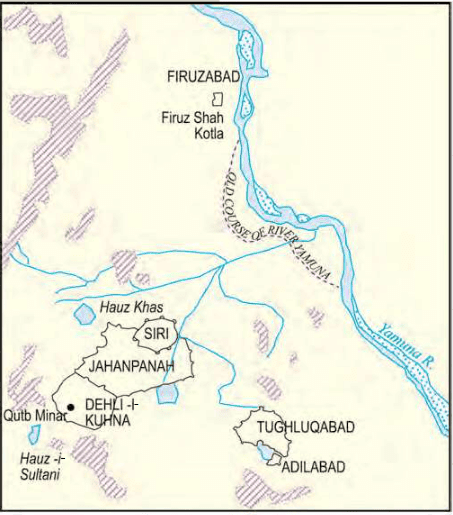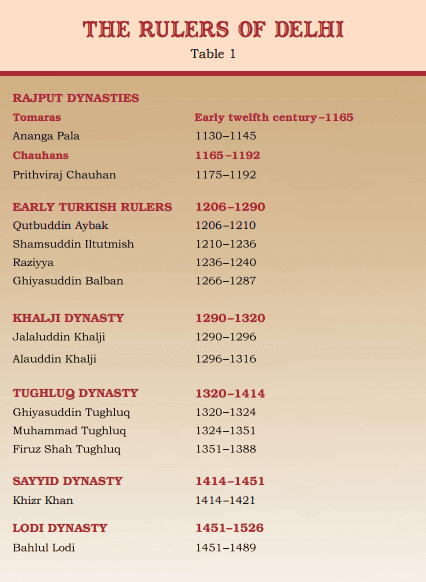Class 7 Exam > Class 7 Notes > Understanding Delhi under the Sultans
Understanding Delhi under the Sultans - Class 7 PDF Download
| Table of contents |

|
| Introduction |

|
| Understanding Delhi under the Sultans |

|
| A Closer Look: Administration under the Khaljis and Tughlugs |

|
| The Sultanate in the Fifteenth and Sixteenth Centuries |

|
Introduction
Transformation of Delhi into a Capital City
- In Chapter 2, we learned about regions like the Kaveri Delta becoming the centers of large kingdoms. However, there was no mention of Delhi as a capital during that time because it only became significant in the twelfth century.
- According to historical records, Delhi first became the capital of a kingdom under the Tomara Rajputs. They were later defeated in the mid-twelfth century by the Chauhans (also known as Chahamanas) from Ajmer.
- Under the Tomaras and Chauhans, Delhi emerged as an important commercial center. The city was home to many wealthy Jaina merchants who built several temples. Coins minted here, called dehliwal, were widely circulated.
 Sultanate cities of Delhi, thirteenth-fourteenth centuries
Sultanate cities of Delhi, thirteenth-fourteenth centuries - The transformation of Delhi into a capital that governed vast regions of the subcontinent began with the establishment of the Delhi Sultanate in the early thirteenth century.
- The Delhi Sultans constructed numerous cities in the area now known as Delhi. Some of these cities include Delhi-i Kuhna, Siri, and Jahanpanah.

Understanding Delhi under the Sultans
Histories during the Delhi Sultanate
- Histories were called tarikh(singular) or tawarikh(plural) in Persian, the administrative language under the Delhi Sultans.
- The authors of tawarikh were learned individuals such as secretaries, administrators, poets, and courtiers. They not only recorded events but also advised rulers on governance, stressing the importance of just rule.
- These authors primarily lived in cities(mainly Delhi) and rarely in villages.
- They often wrote histories for the Sultans with the hope of receiving rich rewards.
- The authors advocated for preserving an "ideal" social order based on birthright and gender distinctions, although not everyone shared these views.
Raziyya Sultan's Reign
- In 1236, Sultan Iltutmish's daughter Raziyya, became Sultan.
- The chronicler Minhaj-us-Siraj acknowledged her as more capable than her brothers but was uncomfortable with a female ruler.
- Nobles were also unhappy with her independent rule, leading to her removal in 1240.
A Closer Look: Administration under the Khaljis and Tughlugs
Reliable Governors and Administrators in the Delhi Sultanate
- The vast Delhi Sultanate required trustworthy governors and administrators for effective management.
- Early Delhi Sultans, especially Iltutmish, preferred to appoint special slaves called bandagan, purchased for military service, as governors instead of aristocrats or landed chieftains.
- Bandagan were carefully trained and totally dependent on their master, making them reliable and trustworthy for important political offices.
- The Khalji and Tughluq dynasties continued to use bandagan and also promoted individuals of humble birth, often their clients, to high political positions, such as generals and governors.
- However, this practice introduced political instability as slaves and clients were loyal to their masters, not their heirs.
- The accession of a new monarch often led to conflicts between the old and new nobility due to the loyalty of the previous nobility to their patrons.
- The appointment of low-born individuals to high offices by the Delhi Sultans shocked many elites and faced criticism from authors of Persian tawarikh.
Military Commanders and Iqtas
- Similar to earlier Sultans, the Khalji and Tughluq monarchs appointed military commanders as governors of regions called iqta.
- The holder of an iqta, known as muqtis or mugti, was responsible for leading military campaigns and maintaining law and order in their assigned territories.
- In exchange for their military services, muqtis collected revenues from their assignments as salary and used these revenues to pay their soldiers.
- Control over muqtis was most effective when their office was non-inheritable and they were assigned iqtas for short periods before being shifted to new assignments.
- These strict conditions were enforced rigorously during the reigns of Alauddin Khali and Muhammad Tughluq.
- The state appointed accountants to monitor the revenue collected by the muqtis, ensuring they collected only the prescribed taxes and maintained the required number of soldiers.
Control Over Landed Chieftains
- As the Delhi Sultans expanded their control, they forced landed chieftains, known as samanta aristocrats, and wealthy landlords to accept Sultanate authority.
- Under Alauddin Khalii, the state took control of land revenue assessment and collection, cancelling the rights of local chieftains to levy taxes and making them pay taxes as well.
- Sultan's administrators measured the land and maintained careful accounts, with some old chieftains and landlords serving as revenue collectors and assessors.
- There were three types of taxes: (1) on cultivation called kharaj(about 50% of the peasant's produce), (2) on cattle, and (3) on houses.
Challenges in Controlling Distant Provinces
- Despite efforts, large parts of the subcontinent remained outside Delhi Sultanate control.
- Distant provinces like Bengal were difficult to manage from Delhi, and soon after annexing southern India, the entire region became independent.
- Even in the Gangetic plain, there were forested areas that Sultanate forces could not penetrate, allowing local chieftains to establish their rule.
- Rulers like Alauddin Khalji and Muhammad Tughluq could sometimes impose control in these areas, but only for a brief period.
Mongol Invasions and Administrative Challenges
- The Mongols, under Genghis Khan, invaded Transoxiana in northeast Iran in 1219, and the Delhi Sultanate faced Mongol attacks shortly after.
- During the reign of Alauddin Khalji and the early years of Muhammad Tughluq, the frequency of Mongol attacks increased.
- In response, both rulers had to mobilize a large standing army in Delhi, creating significant administrative challenges.
The Sultanate in the Fifteenth and Sixteenth Centuries
Post-Tughlaq Era and Regional Powers
- After the Tughluq dynasty, the Sayyid and Lodi dynasties ruled from Delhi and Agra until 1526.
- By this time, regions like Jaunpur, Bengal, Malwa, Gujarat, Rajasthan, and South India had independent rulers who established flourishing states and prosperous capitals.
- New ruling groups such as the Afghans and Rajputs emerged during this period.
- Some of the newly established states, though small, were powerful, well-administered, and prosperous.
Sher Shah Suri and His Administration
- Sher Shah Suri (1540-1545) began his career as the manager of a small territory in Bihar and eventually defeated Mughal emperor Humayun.
- He captured Delhi and established his own dynasty, the Sur dynasty, which lasted for only fifteen years (1540-1555).
- Despite its short duration, the Sur dynasty introduced an efficient administration that improved upon the methods of Alauddin Khilji.
- Sher Shah's administrative practices became a model for the great Mughal emperor Akbar when he consolidated the Mughal Empire (1556-1605).
Understanding Delhi under the Sultans
- Histories during the Delhi Sultanate were called tarikh(singular) or tawarikh(plural) and were written in Persian, the administrative language of the time.
- The authors of these histories were educated individuals such as secretaries, administrators, poets, and courtiers. They not only recorded events but also offered advice to rulers on governance, stressing the importance of just rule.
- These authors typically lived in cities, mainly Delhi, and rarely in villages. They often wrote histories for the Sultans in hopes of receiving rich rewards.
- The writers of tawarikh believed in preserving an "ideal" social order based on birthright and gender distinctions. However, their views were not universally accepted.
- In 1236, Sultan Iltutmish's daughter,Raziyya, became Sultan. The chronicler Minhaj-us-Siraj noted her capabilities and qualifications, finding her more capable than her brothers. However, he and the nobles were uncomfortable with a female ruler.
- Raziyya faced resistance due to her attempts to rule independently and was eventually removed from the throne in 1240.
Related Searches













